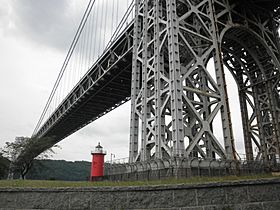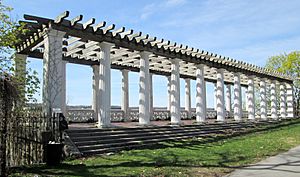Fort Washington Park (Manhattan) facts for kids
Quick facts for kids Fort Washington Park |
|
|---|---|

Fort Washington Park view of the Little Red Lighthouse and George Washington Bridge
|
|
| Location | Along the Hudson River from 155th Street to Dyckman Street Upper Manhattan, New York |
| Area | 160 acres (65 ha) |
| Created | 1896 |
| Etymology | Fort Washington |
| Operated by | NYC Parks |
| Open | 6 a.m. to 1 a.m. |
| Website | http://www.nycgovparks.org/parks/fort-washington-park |
Fort Washington Park is a cool public park in New York City. It's located in the Washington Heights area of Upper Manhattan. This park stretches along the Hudson River, right next to Riverside Drive and the Henry Hudson Parkway. It runs all the way from West 155th Street to Dyckman Street.
The huge George Washington Bridge crosses high above the park. Underneath the bridge, there's a small piece of land called Jeffrey's Hook. This is where you can find the famous Little Red Lighthouse.
This park is about 160-acre (65 ha) big. It offers amazing views of the New Jersey Palisades across the river. You can also get a great look at the George Washington Bridge. The park has lots of fun things to do. There are paths for walking and biking, baseball fields, basketball courts, and tennis courts. You'll also find volleyball courts, a soccer field, and a playground for kids.
Contents
What's in a Name?
The park is named after Fort Washington. This was a very important fortified spot during the American Revolutionary War. A big battle, called the Battle of Fort Washington, happened here in 1776. The actual site of the old fort is now in Bennett Park, which is nearby.
Exploring the Park's Location
Fort Washington Park covers about 160 acres (65 ha). It's bordered by the Hudson River on the west side. To the north, you'll find Dyckman Street. The Henry Hudson Parkway is on its east side, and 155th Street is to the south.
The park connects to other cool parks nearby. It links up with Inwood Hill Park to the north. It also connects to Fort Tryon Park and Riverside Park to the south. All these parks are part of the Manhattan Waterfront Greenway. This is a long path along the water.
A Look Back in Time
During the American Revolutionary War, soldiers built strong forts on the cliffs east of the park. These were known as Fort Washington. On November 16, 1776, a big fight happened here. British troops took over Fort Washington after a two-hour battle. They renamed it Fort Knyphausen. This was after a general named Wilhelm von Knyphausen. The British left Manhattan peacefully in 1783. Later, the fort was taken down. The area then became known as Washington Heights. You can still find a rock in the park that remembers the "American Redout" near 181st Street.
In the late 1800s, famous landscape designer Frederick Law Olmsted helped plan parks like Riverside and Fort Washington. He wanted them to fit in with the natural land. Fort Washington Park was officially created in 1894. Over the next few years, the city bought most of the land for the park.
In the early 1900s, people suggested building new things in the park. These ideas included a hotel annex and a theater. But neighbors didn't want them, so they were never built. Two important structures were built around this time. These were the Little Red Lighthouse and the Inspiration Point shelter.
In 1917, John D. Rockefeller Jr. bought Fort Tryon Park. He gave it to the city. But he had a condition: it had to connect to Fort Washington and Riverside Parks. He also bought land across the Hudson River. This was to keep the views from the parks beautiful. This land later became Palisades Interstate Park. The city bought more land in 1921 to connect the parks.
In 1927, part of Fort Washington Park was given to the Port Authority. They built the huge George Washington Bridge right over the park. Some people worried the bridge towers would spoil the park's beauty. But the bridge opened in 1931. The connection to Fort Tryon Park opened four years later. The Henry Hudson Parkway, which runs next to the park, opened in 1936.
Over the years, more land was added to Fort Washington Park. In 2013, a survey found the park was actually 24 acres (9.7 ha) bigger than thought. This made the park a total of 160 acres.
The park has also seen many improvements. In 1994, a new bridge was built to help people get into the park. A marina opened at Dyckman Street in 1995. The Lily Brown Playground was updated between 2001 and 2002. In 2014, a new 1-mile (1.6 km) bike path opened. It runs from Dyckman Street to 186th Street.
Cool Structures in the Park
Inspiration Point
The Inspiration Point shelter is a special building in the park. It's near the Henry Hudson Parkway and 181st Street. Gustave Steinacher designed it in a Neoclassical style. It opened in 1925. The shelter had two levels. The top level had a deck with cool columns and a wooden trellis. The bottom level had restrooms. It used to be a popular spot, but it's not used much anymore.
The Little Red Lighthouse
The Little Red Lighthouse sits on a small piece of land called Jeffrey's Hook. This is right under the George Washington Bridge. This lighthouse wasn't always here. It was first at Sandy Hook, New Jersey. It stopped being used there in 1917. The United States Lighthouse Establishment moved it to Fort Washington Park in 1921.
The lighthouse was stopped from being used in 1948. This was because the George Washington Bridge was built. The bridge's bright lights made the lighthouse less needed. The United States Coast Guard wanted to sell the lighthouse. But kids in the area protested! They loved the lighthouse. So, the Coast Guard decided not to sell it. Since 1951, NYC Parks has taken care of it. The Little Red Lighthouse is now a very important historical site. It's on the National Register of Historic Places. It's also a designated New York City Landmark.
Dyckman Street Boat Marina
The Dyckman Street Boat Marina is at the very north end of the park. It's at the end of Dyckman Street. This spot used to be where a car float crossed the Hudson River. That closed in 1941. In 1966, the land was given to NYC Parks. Later, a group wanted to build a marina, a pier, and a restaurant here. NYC Parks said yes. The marina opened in 1995. It also has a fishing pier for everyone to enjoy.
Fun Sports and Play Areas
Fort Washington Park has the Lily Brown Playground at 162nd Street. This playground was built on land bought in 1925. It's named after Lily Brown. She was a local person who worked hard to get the playground fixed up in the 1980s and 1990s. The playground was renovated in the early 2000s.
The southern part of the park has lots of sports fields. You can find two baseball fields and a soccer field. There are also five softball fields, a basketball court, and ten handball courts. The area between 155th and 165th Streets is where most of the active sports facilities are in Fort Washington Park.




